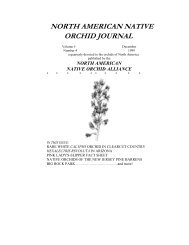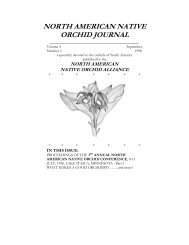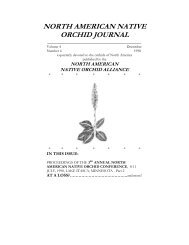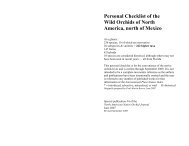north american native orchid journal - at The Culture Sheet
north american native orchid journal - at The Culture Sheet
north american native orchid journal - at The Culture Sheet
Create successful ePaper yourself
Turn your PDF publications into a flip-book with our unique Google optimized e-Paper software.
Folsom: A CASE FOR EVOLUTION<br />
calcareous habit<strong>at</strong>s and even in the cracks of the sidewalks in<br />
Boston! Dactylorhiza found in Ontario and Newfoundland present<br />
another problem in th<strong>at</strong> although the species are European in<br />
their primary distribution. <strong>The</strong>ir arrival in <strong>north</strong>ern North<br />
America has not been documented and as they are in similar<br />
habit<strong>at</strong>s as in <strong>north</strong>ern Europe their alien st<strong>at</strong>us is unsure.<br />
Orchids are still evolving and meeting the conditions of<br />
their environment. <strong>The</strong>re are <strong>orchid</strong>s th<strong>at</strong> have adapted to<br />
mowing and consistently bloom on spikes th<strong>at</strong> stay below the<br />
mowers blades. Orchids have seeded into human areas where they<br />
can find the right conditions such as the lime leaching from<br />
cement sidewalks and roadways. <strong>The</strong>y are traveling on hurricanes,<br />
in cargoes from other countries, along railways and roadways as<br />
they seed into new places.<br />
Wh<strong>at</strong>ever the process, however, North American <strong>orchid</strong>s<br />
have proven they are survivors and will hopefully be around for<br />
many more millennia to come. <strong>The</strong> prospect invites conjecture as<br />
to wh<strong>at</strong> new and exciting forms will evolve in the future.<br />
Liter<strong>at</strong>ure Cited:<br />
C<strong>at</strong>ling, P. M. 1980. Rain-assisted autogamy in Liparis loeselii (L.) L. C. Rich.<br />
(Orchidaceae). Bulletin of the Torrey Botanical Club107:525-529.<br />
Darwin, C. 1859. On the origin of species by means of n<strong>at</strong>ural selection. London. John<br />
Murray. [1st edn].<br />
-------. 1862. On the various contrivances by which British and foreign <strong>orchid</strong>s are<br />
fertilised by insects. London. John Murray.<br />
Hammer, R. 1996. A Week in the Fakah<strong>at</strong>chee. Orchids. 65(3): 252-261.<br />
Sheviak, C. J. 1982. Biosystem<strong>at</strong>ic study of the Spiranthes cernua<br />
complex. Bull. New York St<strong>at</strong>e Mus. Sci. Serv. 448.<br />
------. 1984. Spiranthes diluvialis (Orchidaceae), a new species from the<br />
western United St<strong>at</strong>es. Brittonia 36: 8–14.<br />
------. 1991. Morphological vari<strong>at</strong>ion in the compilospecies Spiranthes<br />
cernua (L.) L.C. Rich.: Ecologically-limited effects of gene flow.<br />
Lindleyana 6: 228–234.<br />
Stan Folsom, 10896 SW 90 th Terrace, Ocala, FL 34481.<br />
Stan has written numerous articles for the NANOJ and is a fine artist<br />
whose work is found in the series of <strong>orchid</strong> field guides co-authored with<br />
Paul Martin Brown.<br />
49













